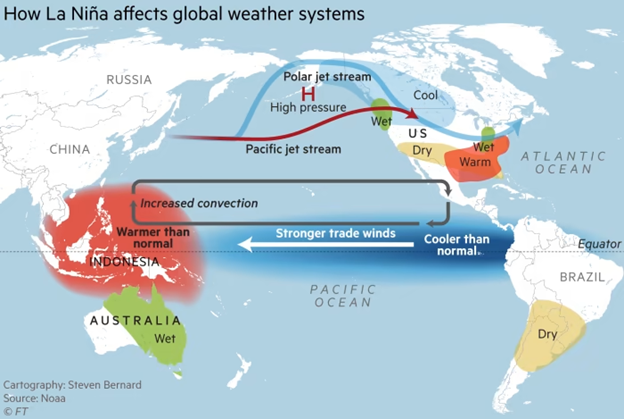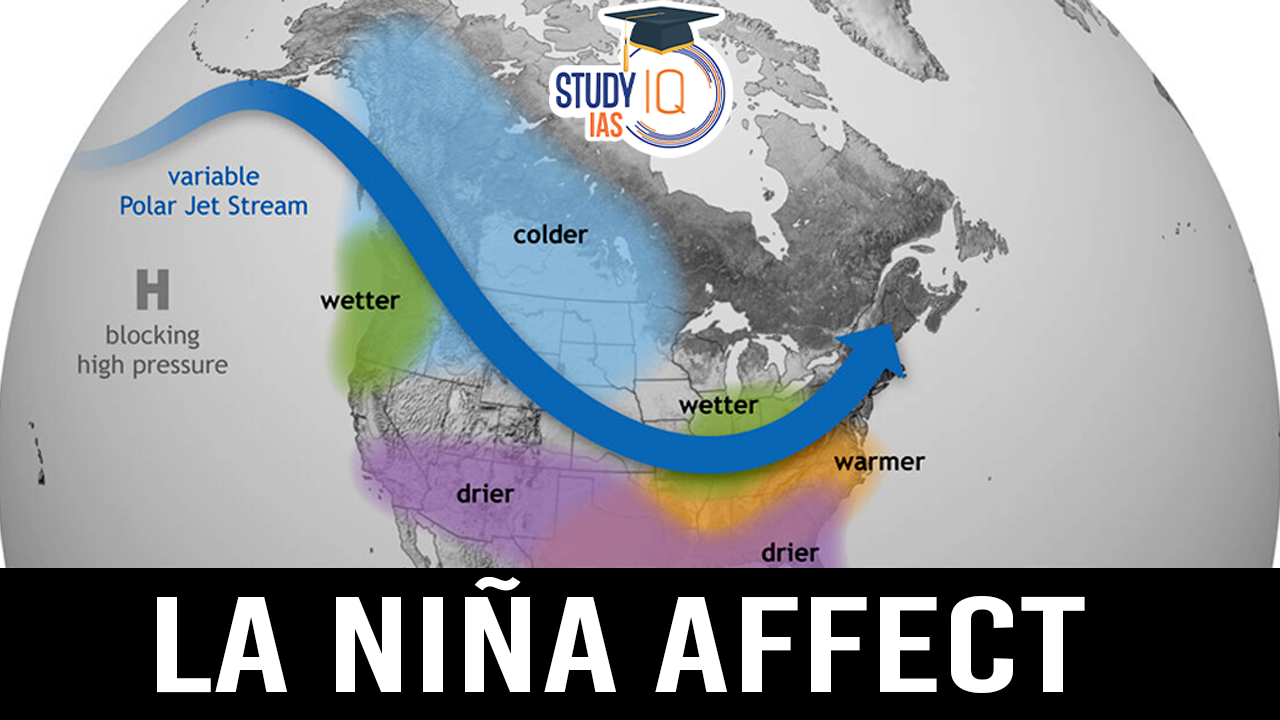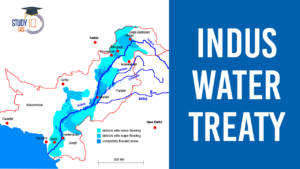Table of Contents
Context: The Copernicus Climate Change Service (C3S) reported that January 2025 was the hottest January on record.
What is La Niña Affect?
La Nina is one of the three phases of the El Nino-Southern Oscillation (ENSO), a climate phenomenon that influences global weather patterns.
- ENSO involves periodic changes in the sea surface temperatures and atmospheric conditions in the Pacific Ocean.
- During La Niña, the sea surface temperatures in the central and eastern equatorial Pacific Ocean become unusually cold.
- This is caused by stronger-than-normal trade winds, which blow from east to west across the Pacific.
- These winds push warm surface water toward the western Pacific (near Asia and Australia), allowing colder water from the ocean depths to upwell (rise) to the surface in the eastern Pacific near South America.
- La Niña events typically last 9–12 months, though they can persist for up to 2 years in some cases.

Phases of ENSO
- Neutral Phase
- The eastern Pacific Ocean (near South America) is cooler than the western Pacific (near Indonesia).
- Trade winds push warm surface water towards Indonesia, allowing cooler waters from below to rise.
- El Niño (Warm Phase)
- Trade winds weaken, reducing the movement of warm waters toward Indonesia.
- As a result, the eastern Pacific becomes warmer than usual.
- This generally leads to higher global temperatures.
- La Niña (Cool Phase)
- Trade winds become stronger, pushing larger amounts of warm water westward.
- This causes colder-than-normal waters in the eastern Pacific.
- Typically results in lower global temperatures.
La Niña’s General Effects on Temperature
- El Niño increases global temperatures, while La Niña cools them.
- However, regional effects vary, and some areas may experience both warming and cooling.
Why Did La Niña Not Cool Temperatures in January 2025?
Weak La Niña Development
- Not all La Niña phases have the same intensity.
- The ongoing La Niña cycle is weak, which reduces its overall cooling effect.
Increased Greenhouse Gas (GHG) Emissions
- Despite La Niña, the rate of increase in atmospheric carbon remained high in 2024 and January 2025.
- Normally, a strong La Niña brings more rain, leading to increased plant growth.
- More plant growth means higher carbon absorption, reducing heat-trapping gases.
- However, this effect was not strong enough this time.
Decline in Aerosol Concentration
- Aerosols (suspended particles in the atmosphere) have a cooling effect by:
- Scattering solar radiation back into space.
- Influencing cloud formation, which affects how much sunlight is absorbed or reflected.
- Due to clean air policies in some regions, aerosol concentrations have decreased.
- This weakened the cooling effect, allowing temperatures to remain high.
| Fact |
| This decade began with three consecutive La Niña events (2020-2022), a rare occurrence known as Triple Dip La Niña (the first since 1998-2001), followed by an El Niño in 2023. |
Impacts of La Niña on Global Climate
The effects of La Niña vary globally but typically include:
Weather Patterns
- Asia and Australia: Higher-than-average rainfall, risk of flooding, and stronger monsoon seasons.
- South America (Pacific Coast): Drier weather, drought conditions.
- North America:
- Cooler and wetter winters in the northern U.S. and Canada.
- Warmer and drier conditions in the southern U.S.
- Africa: Wetter conditions in eastern Africa but drought in southern Africa.
Hurricanes and Cyclones
La Niña typically increases the frequency and intensity of hurricanes in the Atlantic Ocean due to reduced vertical wind shear.
Global Climate Impact
It can lead to temporary global cooling, as the colder Pacific waters influence global temperatures.
| Climate Change and La Nina |
|
India and La Niña (2025): Localized Impacts
Colder and Wetter Winters
- Northern and northwestern states like Punjab, Haryana, and Rajasthan may experience prolonged cold spells and dense fog.
- Disruptions to daily life and transportation are likely.
- Cooler temperatures can benefit crops like wheat, but extreme cold may negatively impact human health and productivity.
Enhanced Monsoon Activity
- Above-average monsoon rains are expected, extending into late September or October.
- Benefits include improved water reservoirs and hydroelectric projects.
- However, the risk of flooding increases in vulnerable regions such as Assam, Bihar, and parts of Maharashtra.
Impact on Agriculture
- Heavier rains can boost rabi (winter) crop production by improving soil moisture.
- Excess rainfall may cause waterlogging in key rice and wheat-growing areas, potentially damaging crops and delaying harvests.
Water Resource Management
- La Niña could help replenish groundwater levels and reservoirs.
- However, unplanned water discharge during heavy rains may trigger flooding in urban areas.
- Coastal cities like Mumbai and Chennai need robust disaster management systems to prevent waterlogging and disruptions.
Public Health Challenges
- Extended rains and cooler temperatures may increase waterborne diseases like cholera and dengue, especially in densely populated urban areas.
- Healthcare preparedness and public awareness campaigns will be essential to manage these health risks.
| Impact of La Niña on Air Quality |
|


 Places in News for UPSC 2025 for Prelims...
Places in News for UPSC 2025 for Prelims...
 Vizhinjam International Seaport Project,...
Vizhinjam International Seaport Project,...
 Indus Water Treaty 1960 Suspended by Ind...
Indus Water Treaty 1960 Suspended by Ind...





















